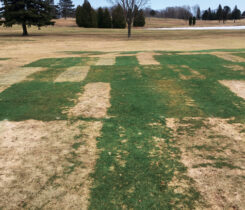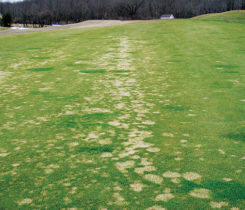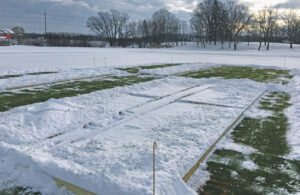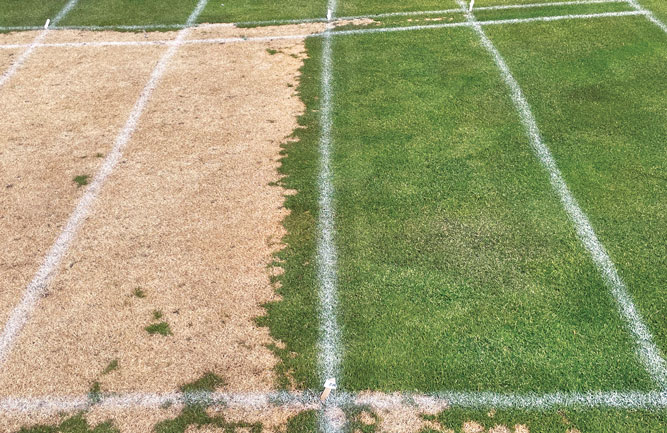Super Science: The bizarro snow mold year
What did we learn and how does this affect next year?
Two years ago, I thought warmer winters from climate change would lead to less snow mold, but the reality is more complex. Fall and winter temperatures have increased, which has generally decreased fall and early winter snowfall totals but has also decreased the level of plant hardening prior to snow cover. This means that when snow does arrive, the plants are more susceptible to snow mold.
If temperatures continue to warm to the point where snowfall is rare even during the middle of winter, then snow mold severity may decrease across the region. Right now, all these warmer winters are leading to more uncertainty about when and where snow mold will develop.
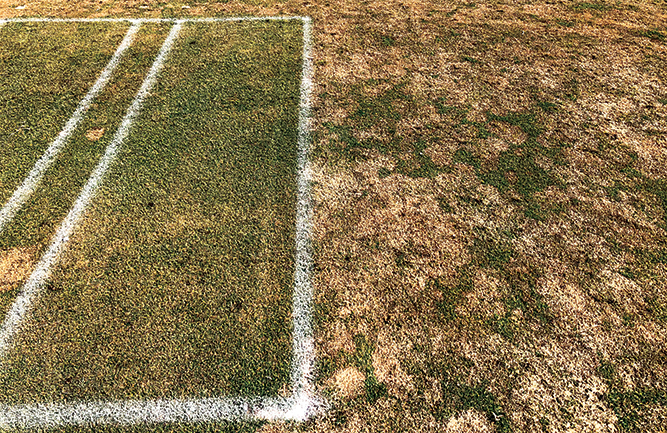
Despite the heavy snow mold pressure in certain areas, fungicides still provided excellent disease control. (Photo courtesy of Paul Koch, Ph.D.)
The timing of the cold snap(s) are important. Snow mold fungi like cold temperatures, but not freezing temperatures, and you can think of a big cold snap that freezes the soil as a fungicide application that kills back snow mold fungi. If that February cold snap had hit Chicago in early January, before the deep snow cover was present, then there would have been very little snow mold development.
Should those places that got nailed with snow mold last winter treat for it this winter? Well, that depends. On the one hand, we know that a snow mold outbreak one winter tends to increase the potential for snow mold the next year because of increased fungal inoculum. On the other hand, this was the first time in 10 years that many in the region had seen snow mold, so what are the chances of that happening two years in a row?
My recommendation is this: If you and/or your management felt the level of snow mold damage this spring was unacceptable, then plan to treat preventively next fall. If everyone was OK with it, continue to leave it untreated.
Lastly, and not surprisingly, snow mold fungicides work. Despite the heavy pressures across the southern Great Lakes, I heard very few cases of disease breakthrough on treated areas. And, you don’t have to break the bank to get good snow mold control in low to moderate pressure environments. Several solid fairway snow mold options exist for less than $5,000.
Despite the spotty snow mold development across the region, our own snow mold research from last winter still provided excellent product evaluation results on pink snow mold (Microdochium nivale) from our Madison, Wis., location and on gray snow mold (Typhula incarnata) from our Marquette, Minn., location.
Other sites we tested include Wausau CC in Wausau, Wis., Giant’s Ridge GC in Biwabik, Minn., and Cragun’s Legacy Course in Brainerd, Minn. I urge you to look at these freely available results at our website to find treatments that work best for your situation.
Research takeaways
-
-
- The conditions were perfect for snow mold to develop across Chicago and much of the southern Great Lakes. In January, a deep and insulating snowpack prevented the February cold snap from affecting fungal growth at the turf surface.
- In January and February, the snow machine never kicked on in Wausau and much of the northern Great Lakes. The February cold snap killed off most of the snow mold fungi and prevented snow mold from developing.
- Despite the spotty snow mold development across the region, last winter’s University of Wisconsin snow mold research still provided excellent product evaluation results on pink snow mold (Microdochium nivale) from our Madison, Wis., location and on gray snow mold (Typhula incarnata) from our Marquette, Minn., location.
-
Paul Koch, Ph.D., is at the University of Wisconsin. Contact Koch via email at plkoch@wisc.edu.









